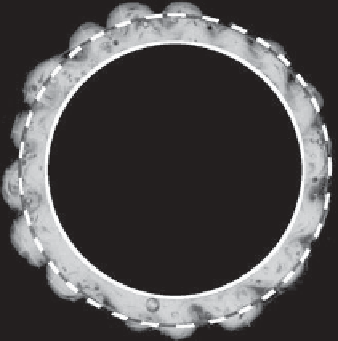Geoscience Reference
In-Depth Information
(a)
(b)
(d)
(c)
Figure 6.16.
Pressure and velocity fields of the upper (a) and lower (b) layers and (c) interface height of the baroclinically unstable
mode at
k
=17(
kR
d
= 5, see Figure 6.15). Full lines: positive; dotted lines: negative values. The field in the upper layer is typical
for a frontal mode, while the field in the lower layer is typical for a Rossby mode. (d) Photograph of the corresponding experiment
adapted from
Griffiths and Linden
[1982].
small Rossby numbers, as ageostrophic by many authors,
because the uniform PV in the upper layer does not satisfy
the Charney-Stern theorem of the PV gradient inversion
between the two layers. Yet, it is still possible to inter-
pret it as generalized quasi-geostrophic instability; see a
discussion of this point by
Boss et al.
[1996].
define a topography parameter To as the ratio of the shelf
slope
γ
to the isopycnal slope
α
,
To =
γ
α
,
(6.18)
where
α
is defined as the slope of the interface between
the layers at the location of the front. The parameter To
has been found relevant for quantifying the shelf impact
on the surface current (
Pennel et al.
[2012]), as was previ-
ously suggested by works in the quasi-geostrophic Phillips
model. Positive values of To, as in Figure 6.9, correspond
to isopycnal and shelf slopes in the same direction, which
is typical of upwelling events along the coast of western
boundary currents. Negative values of To correspond to
6.4. IMPACT OF BATHYMETRY
ON INSTABILITIES
In this section we study the impact of bathymetry in a
form of a constant-slope shelf on the stability of the flow.
We use the same set of equations and parameters as in the
previous section with the addition of a bottom topogra-
phy with height
H
t
(r)
. Following
Pennel et al.
[2012], we




















